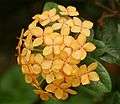Ixora
| Ixora | |
|---|---|
.jpg) | |
| Ixora coccinea | |
| Scientific classification | |
| Kingdom: | Plantae |
| (unranked): | Angiosperms |
| (unranked): | Eudicots |
| (unranked): | Asterids |
| Order: | Gentianales |
| Family: | Rubiaceae |
| Subfamily: | Ixoroideae |
| Tribe: | Ixoreae |
| Genus: | Ixora L. |
| Type species | |
| Ixora coccinea L. | |
| Synonyms | |
| Wikispecies has information related to: Ixora |
| Wikimedia Commons has media related to Ixora. |
Ixora is a genus of flowering plants in the Rubiaceae family. It is the only genus in the tribe Ixoreae. It consists of tropical evergreen trees and shrubs and holds around 545 species.[1] Though native to the tropical and subtropical areas throughout the world, its centre of diversity is in Tropical Asia. Ixora also grows commonly in subtropical climates in the United States, such as Florida where it is commonly known as West Indian Jasmine. Other common names include viruchi, rangan, kheme, ponna, chann tanea, techi, pan, santan, jarum-jarum, jungle flame, jungle geranium among others. The plants possess leathery leaves, ranging from 3 to 6 inches in length, and produce large clusters of tiny flowers in the summer. Members of Ixora prefer acidic soil, and are suitable choices for bonsai. It is also a popular choice for hedges in parts of South East Asia. In tropical climates they flower year round and are commonly used in Hindu worship, as well as in ayurveda and Indian folk medicine.
Selected species

|
Gallery
-

-

-

-
-

-

-

-

Ixora chinensis
-
whitish pink Ixora
-
pink orange ixora
-
white Ixora
References
- ↑ "Ixora in the World Checklist of Rubiaceae". Retrieved October 2015.




